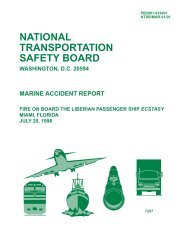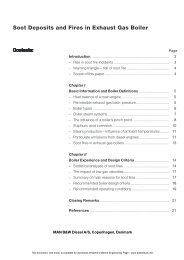“Don’t paint your ship with rocket fuel”At 7:30, on the evening of May 6, 1937, the Hindenburg dirigible was destroyed by fire and explosions as it was about to land inLakehurst, New Jersey. 62 passengers survived and 35 lost their lives. The Hindenburg was nearing its landing site during anelectric storm. According to observers on the ground, the dirigible began to drift past its landing position, and after a brief delay,the ship started to valve hydrogen into what was highly charged outside air. This combination of factors could prompt severecorona activity on any airship. In fact, an eyewitness reported seeing a blue glow of electrical activity atop the ill-fated Hindenburgbefore the fire started, which is indicative of the extremely high temperatures typical of a corona discharge. As the crewattempted to bring it back on course, the ship lost its balance, the tail touched the ground, and the stern burst into flames. Passengerswho were afraid the ship might explode, jumped to their deaths. The burns and other injuries were a result of the diesel fuelfire, not from hydrogen. Most of thepassengers, who waited for the airship toland, walked safely away from the accident.Until recently, this tragedy was thoughtto be caused by hydrogen, the highlyflammable gas used to inflate the skin ofthe ship. However, historical photographsshow red-hot flames, andhydrogen burns invisibly. Also, no onesmelled garlic, the scent which had beenadded to the hydrogen to help detect aleak. The mystery of the Hindenburgwas solved by Addison Bain, a formermanager of the hydrogen programs forNASA. Using infrared spectrographs anda scanning electron microscope, Bain,working with other NASA scientists, wasable to discover the chemical makeup ofthe organic compounds and elementspresent in the fabric of the dirigible’sskin. The Hindenburg was covered with acotton fabric that had been treated with adoping compound to protect andstrengthen it — however, this compoundcontained a cellulose acetate or nitrate(gunpowder). Aluminum powder (whichis used in rocket fuel) was also identified.The outside structure was wooden andthe inside skeleton was duralumin coatedwith lacquer. The combination was flammableand deadly.Front page of The New York Times, May 7, 1937, the day after the explosionof the Hindenberg. (Enhanced color photograph courtesy: National Hydrogen Association)This document, and more, is available for download at <strong>Martin's</strong> <strong>Marine</strong> <strong>Engineering</strong> <strong>Page</strong> - www.dieselduck.net
The Evolution ofthe Zero EmissionVehicle (in the 1990’s)The 1990 Clean Air Act Amendments along withthe National Energy Policy Act of 1992 pavedthe way for less polluting gasoline vehicles andthe introduction of alternative fuel vehicles onthe roads in the U.S. Also in 1990, the CaliforniaAir Resources Board recognized that eventhe cleanest gasoline powered vehicles wouldn’treduce pollution enough to satisfy the state’sgoals for healthful air. Meeting state and federalair standards in seriously polluted areassuch as Los Angeles would require either restrictionson driving or a large-scale switch tovehicles that don’t pollute. California adoptedthe Low Emission Vehicle Act that mandated theseven largest auto manufacturers begin immediatelyto reduce all tailpipe emissions and tointroduce zero emission vehicles (ZEVs) by1998.In March 1996, the California Air ResourcesBoard modified their zero emission vehicle programto encourage a market based introductionin the near-term and to promote future advancesin electric vehicle (including fuel cells)technology. Beginning in 2003, 10% of thenew vehicles will be required to be zero emissionvehicles or nearly zero emission vehicles— also knows as equivalent ZEVs.Because of the legislative initiative taken byCalifornia and subsequent similar regulationsimposed by a number of states in the Northeast,every major automobile manufacturer hasmade significant progress toward the developmentof ultra-low and zero emission vehicles.The remarkable developmentsof fuel-cell engines will helpCalifornia in its war on smog aswell as provide new consumerschoices for transportation.Getting To CleanerTransportationThe success story of the past three decades in the transportation sector hasbeen the dramatic reduction of air-polluting emissions from new vehicles.Emission rates of gasoline vehicles have fallen by 70 – 90%, and thecosts for cleaner cars have also fallen. Under real driving conditions, actualreductions are about 70% for nitrogen oxides and 90% for hydrocarbon andcarbon monoxide emissions. With a near zero emission gasoline car on thehorizon, and legislation in California and the Northeast states mandating10% of the new vehicle market to be zero emission vehicles by 2003, evengreater reductions in emissions are imminent. These are important improvementsin the U.S. — but still, one in four Americans breathes unhealthy air.It’s worse in the rest of the world. Cities such as Mexico City, Athens, andShanghai don’t have the same stringent emissions standards found at home —and transportation remains the largest contributor to urban pollution.Worldwide, over one billion people living in urban areas are suffering fromsevere air pollution, and according to the World Bank, over 700,000 deathsresult each year.Estimates from the EPA indicatethat motor vehicles in the U.S. still account for• 78% of all Carbon Monoxide emissions• 45% of Nitrogen Oxide emissions• 37% of Volatile Organic CompoundsThe impact of lower emission gasoline vehicles is being offset by the growthin the number and size of vehicles on the road as well as an increase in thenumber of miles each vehicle travels. Americans pay around $.36 per gallonin fuel tax as opposed to our European counterparts who spend an average of$2.50 per gallon in taxes. Low gasoline prices don’t encourage fuel efficiencyor conservation. Rather, the sport utility vehicle market share continues torise, now surpassing passenger vehicles. Even as these larger vehicles havecleaner tailpipe emissions, energy use and carbon dioxide emissions willcontinue to increase. If recent growth trends continue, Americans will bedriving twice as many miles in 2015 as we do today. Along with continuingresearch on cleaner transportation options, it will be critical to developpolicies that decrease the number of cars on the road, minimize congestion,encourage public transportation as well as telecommuting.California Air Resources Board, August, 1998This document, and more, is available for download at <strong>Martin's</strong> <strong>Marine</strong> <strong>Engineering</strong> <strong>Page</strong> - www.dieselduck.net27

















